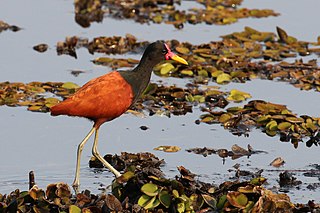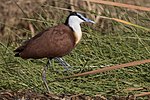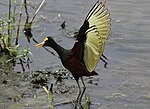
Charadriiformes is a diverse order of small to medium-large birds. It includes about 390 species and has members in all parts of the world. Most charadriiform birds live near water and eat invertebrates or other small animals; however, some are pelagic (seabirds), others frequent deserts, and a few are found in dense forest. Members of this group can also collectively be referred to as shorebirds.

Loons or divers are a group of aquatic birds found in much of North America and northern Eurasia. All living species of loons are members of the genus Gavia, family Gaviidae and order Gaviiformes.

The American horned owls and the Old World eagle-owls make up the genus Bubo, at least as traditionally described. The genus name Bubo is Latin for owl.

Waders or shorebirds are birds of the order Charadriiformes commonly found wading along shorelines and mudflats in order to forage for food crawling or burrowing in the mud and sand, usually small arthropods such as aquatic insects or crustaceans. The term "wader" is used in Europe, while "shorebird" is used in North America, where "wader" may be used instead to refer to long-legged wading birds such as storks and herons.

Scolopacidae is a large family of shorebirds, or waders, which mainly includes many species known as sandpipers, but also others such as woodcocks, curlews and snipes. The majority of these species eat small invertebrates picked out of the mud or soil. Different lengths of bills enable different species to feed in the same habitat, particularly on the coast, without direct competition for food.

The crab-plover or crab plover is a bird related to the waders, but sufficiently distinctive to merit its own family Dromadidae. Its relationship within the Charadriiformes is unclear, some have considered it to be closely related to the thick-knees, or the pratincoles, while others have considered it closer to the auks and gulls. It is the only member of the genus Dromas and is unique among waders in making use of ground warmth to aid incubation of the eggs.

The seedsnipes are a small family, Thinocoridae, of small gregarious waders which have adapted to a herbivorous diet. The family is divided into two genera, Attagis and Thinocorus, each containing two species. The family has a South American distribution, in the Andean and Patagonian regions. The relationships with other families within the order Charadriiformes are uncertain; it has been suggested that the plains wanderer of Australia, the jacanas and the painted snipes are their closest relatives. The plains wanderer in particular has a similar feeding ecology, although differs markedly in breeding biology. The family's common name is misleading, as they do not resemble true snipe, having short bills on small heads, and seeds do not form a major part of the diet. One species Thinocorus rumicivorus is however known to feed on the fleshy flower petal appendages of Calceolaria uniflora, a species of Scrophularaceae. In the process of feeding on these sugar rich appendages, they also pollinate the flowers.

Buttonquail or hemipodes are members of a small family of birds, Turnicidae, which resemble, but are not closely related to, the quails of Phasianidae. They inhabit warm grasslands in Asia, Africa, Europe, and Australia. There are 18 species in two genera, with most species placed in the genus Turnix and a single species in the genus Ortyxelos.

Tringa is a genus of waders, containing the shanks and tattlers. The genus name Tringa is the Neo-Latin name given to the green sandpiper by the Italian naturalist Ulisse Aldrovandi in 1599. They are mainly freshwater birds, often with brightly coloured legs as reflected in the English names of six species, as well as the specific names of two of these and the green sandpiper. They are typically associated with northern hemisphere temperate regions for breeding. Some of this group—notably the green sandpiper—nest in trees, using the old nests of other birds, usually thrushes.

The African jacana is a wader in the family Jacanidae. It has long toes and long claws that enables it to walk on floating vegetation in shallow lakes, its preferred habitat. It is widely distributed in sub-Saharan Africa. For the origin and pronunciation of the name, see Jacanidae.

The bronze-winged jacana is a wader in the family Jacanidae. It is found across South and Southeast Asia and is the sole species in the genus Metopidius. Like other jacanas it forages on lilies and other floating aquatic vegetation, using its long feet and legs for balance. The sexes are alike but females are slightly larger and are polyandrous, maintaining a harem of males during the breeding season in the monsoon rains. Males maintain territories, with one male in the harem chosen to incubate the eggs and take care of the young. When threatened, young chicks may be carried to safety by the male under his wings.

The pheasant-tailed jacana is a jacana in the monotypic genus Hydrophasianus. Like all other jacanas, they have elongated toes and nails that enable them to walk on floating vegetation in shallow lakes, their preferred habitat. They may also swim or wade in water reaching their body while foraging mainly for invertebrate prey. They are found in tropical Asia from Yemen in the west to the Philippines in the east and move seasonally in parts of their range. They are the only jacanas that migrate long distances and have different non-breeding and breeding plumages. The pheasant-tailed jacana forages by swimming or by walking on aquatic vegetation. Females are larger than males and are polyandrous, laying several clutches that are raised by different males in their harem.

The wattled jacana is a wader in the family Jacanidae found throughout much of South America east of the Andes, as well as western Panama and Trinidad. It is the only species in the Jacanidae family with such a large distribution. Wattled jacanas have long toes and claws which help them walk through aquatic vegetation. Like the majority of species of jacanas, the female is larger than the male, and forms harems of up to 4 or 5 males at any given time. There is also a major difference in proportional development or ornamentation and defense relative to body size when compared to males.

The northern jacana or northern jaçana is a wader which is known as a resident breeder from coastal Mexico to western Panama, and on Cuba, Jamaica and Hispaniola in the Caribbean. It sometimes known to breed in Texas, United States, and has also been recorded on several occasions as a vagrant in Arizona. The jacanas are a group of wetland birds, which are identifiable by their huge feet and claws, which enable them to walk on floating vegetation in the shallow lakes that are their preferred habitat. In Jamaica, this bird is also known as the 'Jesus bird', as it appears to walk on water.

Actitis is a small genus of waders, comprising just two very similar bird species.

The comb-crested jacana, also known as the lotusbird or lilytrotter, is the only species of jacana in the genus Irediparra. Like other jacana species, it is adapted to the floating vegetation of tropical freshwater wetlands.

The long-toed lapwing , also known as the long-toed plover, is a species of wading bird in the lapwing subfamily, within the family Charadriidae. It is mainly sedentary and found across central and eastern Africa, from Chad and South Sudan in the north to Mozambique in the southeast of its range. It is one of 13 species of ground-nesting lapwings found in Africa.

The lesser jacana is a wader in the family Jacanidae and can be found in Africa. It can be recognized by its long legs and claws that allow it to walk on aquatic vegetation – although it is not to be confused with the larger African Jacana. The lesser jacana is insectivorous. Its conservation status is of least concern.
Paleontology or palaeontology is the study of prehistoric life forms on Earth through the examination of plant and animal fossils. This includes the study of body fossils, tracks (ichnites), burrows, cast-off parts, fossilised feces (coprolites), palynomorphs and chemical residues. Because humans have encountered fossils for millennia, paleontology has a long history both before and after becoming formalized as a science. This article records significant discoveries and events related to paleontology that occurred or were published in the year 1999.
Paleontology or palaeontology is the study of prehistoric life forms on Earth through the examination of plant and animal fossils. This includes the study of body fossils, tracks (ichnites), burrows, cast-off parts, fossilised feces (coprolites), palynomorphs and chemical residues. Because humans have encountered fossils for millennia, paleontology has a long history both before and after becoming formalized as a science. This article records significant discoveries and events related to paleontology that occurred or were published in the year 1976.



























